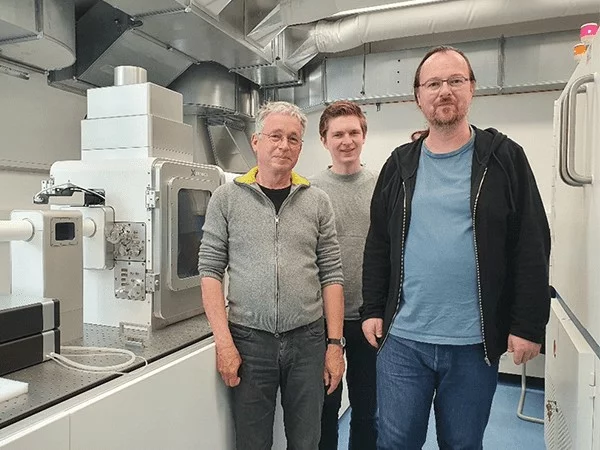Over a year after the installation of the Xeuss 3.0 in the Division of Hybrid Materials Systems in the Institute of Materials Mechanics at Helmholtz-Zentrum Hereon, the system is extensively used and strengthens the institute’s microstructural characterisation facilities for materials science. Dr Jürgen Markmann from the Institute of Materials Mechanics shares with us how the instrument is being used and the benefits it brings.
From WAXS to USAXS, we use the Xeuss 3.0 for structural characterization of materials of very different types

From left to right: Jörg Weißmüller (Head of department), Lukas Riedel, Jürgen Markmann
Our focus in SAXS studies lies in structural characterisations of materials on the nanoscale. Especially nanoporous metals are intensely studied subjects of our research and the possibilities for characterisation the Xeuss 3.0 offers were the main reason for its acquisition.
The pore sizes in nanoporous gold, which is our most frequently investigated model material, ranges from 10 nm to more than 500 nm. Our Xeuss can easily change the measuring geometry optimal to the pore size of interest. Samples in the upper size classes partly leave the accessible range of the standard SAXS. In these cases, we use the supplied Bonse-Hart camera (Ultra-SAXS) for structural characterisation.
Other research projects with this material include the observation of the wide-angle scattering pattern (WAXS) of nanoporous gold which change for instance after annealing steps due to internal stresses. Setups and environments for ex-situ and in-situ experiments in order to investigate initial and advanced stages of the synthesis, i.e. the formation of the microstructure of these materials, are developed.
Non-porous materials also are part of our research work with the Xeuss. For example, we did investigations of precipitates in Mg rare earth alloys. The superstructure of the precipitate phase causes additional WAXS patterns, which we could nicely observe.
Nevertheless, we are not restricted to structural metallic materials. A research project of Julia Keppler (Wageningen University) and Vasyl Haramus (Institute of Metallic Biomaterials, Hereon) is connected with production of artificial milk and cheese from recombinantly produced milk proteins. The critical task is the formation of solution of casein micelles (size above 100 of nm) including “cherry stones” colloidal calcium phosphate nanoclusters (~ 2 nm). SAXS data provides information on variation of morphology of such multi scale structure vs preparation conditions.
Having the instrument in the lab gives us unlimited time for making measurements
Working with nanoscale materials, small-angle scattering always was a very attractive characterisation method for us. Before we bought the Xeuss, our own facilities for doing such measurements were very limited. So writing proposals for measuring time at corresponding beamlines of synchrotron and/or neutron sources was our preferred way for doing SAXS or SANS. However, measuring time at these facilities is in great demand and strictly limited. This makes the development of more sophisticated sample environments difficult.
A lab device like the Xeuss solves this problem. We have unrestricted access for all kind of modifications of the sample environment and unlimited time for testing different measuring geometries. In the few cases we need the high intensity of the synchrotron, e.g. for better time resolution in structural development processes due to shorter measuring times, it’s now much easier to write a successful application for measuring time at SAXS or SANS beamlines due to the preliminary studies we already can do in our own lab.
The Xeuss 3.0 exceeds all expectations we had
What we especially like about the Xeuss 3.0 is the flexibility of the device. The direct control of the motors together with the possibility to change the wavelength and the sample to detector distance according to the needs of the experiment without the need to change the setup allows for measurement designs no one had in mind before.
The variety of sample holders further enhances the number of different measurement geometries including combinations with custom-made sample holders and environments.
If you try new configurations or otherwise need help the Xenocs support service is always available and capable.
Even after more than a year, we still did not explore all possibilities our Xeuss provides. Until now, the device fulfils and even exceeds all expectations we had.
About Helmholtz-Zentrum Hereon
Helmholtz-Zentrum Hereon conducts international cutting-edge research for a changing world: approximately 1,100 employees generate knowledge and innovation to facilitate more resilience and sustainability. Hereon’s scientific spectrum encompasses high-performance materials, processes and environmentally friendly technologies for mobility and new energy systems. Furthermore, research is conducted on biomaterials for medicine and for increasing the quality of life. Through research and consulting, Hereon addresses the challenges of climate change in a solution-oriented manner and facilitates sustainable management as well as the protection of the coasts and marine environment through comprehensive scientific understanding. From basic understanding to practical applications – the interdisciplinary research centre covers a unique spectrum.
Contact : Dr. Jürgen Markmann [[email protected]]
https://www.hereon.de/institutes/materials_mechanics/index.php.en
































